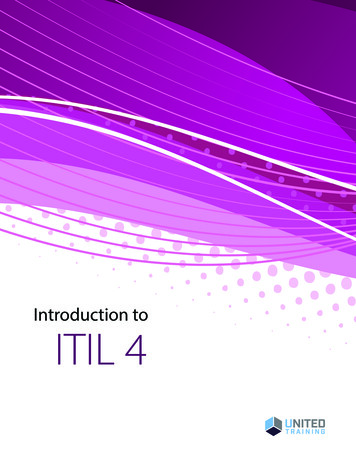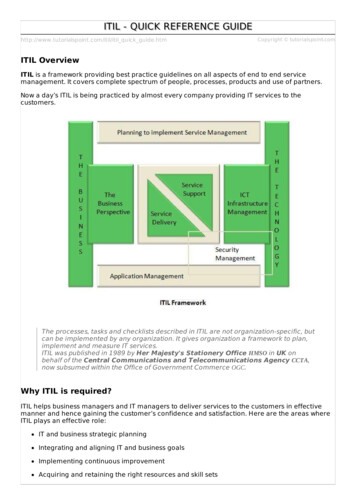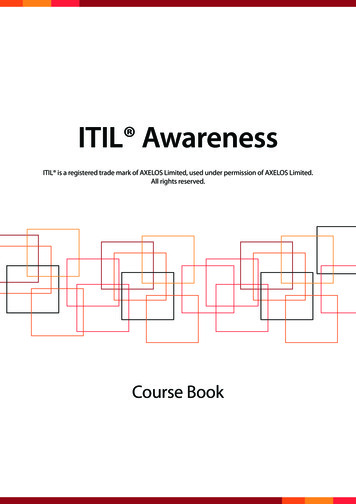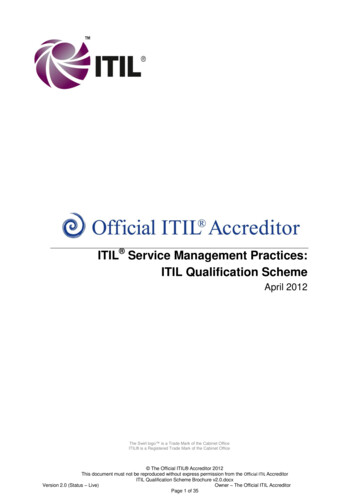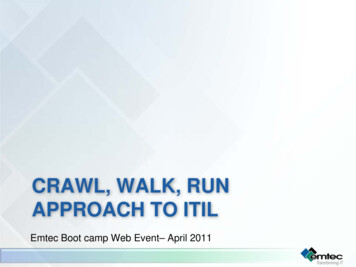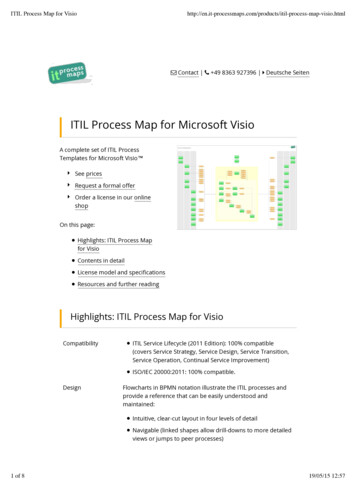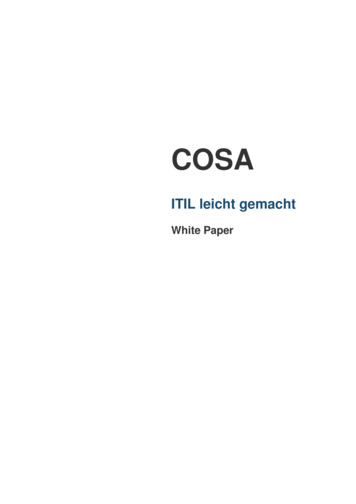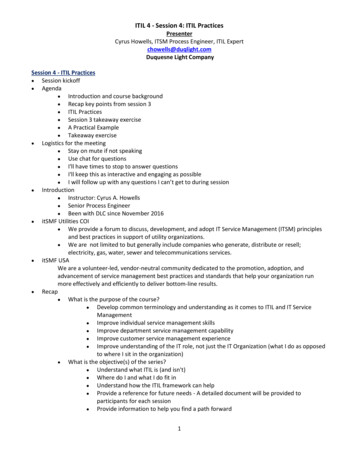
Transcription
ITIL 4 - Session 4: ITIL PracticesPresenterCyrus Howells, ITSM Process Engineer, ITIL Expertchowells@duqlight.comDuquesne Light CompanySession 4 - ITIL Practices Session kickoff Agenda Introduction and course background Recap key points from session 3 ITIL Practices Session 3 takeaway exercise A Practical Example Takeaway exercise Logistics for the meeting Stay on mute if not speaking Use chat for questions I'll have times to stop to answer questions I'll keep this as interactive and engaging as possible I will follow up with any questions I can’t get to during session Introduction Instructor: Cyrus A. Howells Senior Process Engineer Been with DLC since November 2016 itSMF Utilities COI We provide a forum to discuss, development, and adopt IT Service Management (ITSM) principlesand best practices in support of utility organizations. We are not limited to but generally include companies who generate, distribute or resell;electricity, gas, water, sewer and telecommunications services. itSMF USAWe are a volunteer-led, vendor-neutral community dedicated to the promotion, adoption, andadvancement of service management best practices and standards that help your organization runmore effectively and efficiently to deliver bottom-line results. Recap What is the purpose of the course? Develop common terminology and understanding as it comes to ITIL and IT ServiceManagement Improve individual service management skills Improve department service management capability Improve customer service management experience Improve understanding of the IT role, not just the IT Organization (what I do as opposedto where I sit in the organization) What is the objective(s) of the series? Understand what ITIL is (and isn't) Where do I and what I do fit in Understand how the ITIL framework can help Provide a reference for future needs - A detailed document will be provided toparticipants for each session Provide information to help you find a path forward1
ITIL 4 - Session 4: ITIL PracticesPresenterCyrus Howells, ITSM Process Engineer, ITIL Expertchowells@duqlight.comDuquesne Light Company From Session 3 - Key Concepts (November 11th) Value (for) Stakeholders (by way of) Products and services (using) Service relationships (while keeping in mind) Outcomes, costs, and risks From Session 3 - The Service Value Chain the ITIL service value chain - A service value chain, the central element of the servicevalue system (SVS), is an operating model that outlines the key activities required torespond to demand and facilitate value realization through the creation andmanagement of products and services Value Chain Activities Plan - The plan value chain activity ensures a shared understanding of thevision, status, and improvement direction for all four dimensions and allproducts and services across an organization Improve - The improve value chain activity ensures continualimprovement of products, services, and practices across all value chainactivities and the four dimensions of service management Engage - The engage value chain activity provides a good understandingof stakeholder needs, transparency, and continual engagement and goodrelationships with all stakeholders Design and Transition - The design and transition value chain activityensures products and services continually meet stakeholder expectationsrelated to quality, costs, and time to market Obtain or build - The obtain or build value chain activity ensures servicecomponents are available when and where they are needed and meetagreed specifications Deliver and support - The deliver and support value chain activity ensuresservices are delivered and supported according to agreed specificationsand stakeholders’ expectationsITIL Practices What's a practice? A management practice is a set of organizational resources designed for performing work oraccomplishing an objective. Practices are what was known as processes before ITIL 4 ITIL 3 was based on five lifecycles and 26 processes Strategy (5) Design (8) Transition (7) Operations (5) Continual Service improvement (1) The ITIL Service Value System includes general management, service management, and technicalmanagement practices, a total of 34 practices2
ITIL 4 - Session 4: ITIL PracticesPresenterCyrus Howells, ITSM Process Engineer, ITIL Expertchowells@duqlight.comDuquesne Light Company General management practices (14) - adopted and adapted for service management from generalbusiness management domains. Architecture management Continual improvement Information security management Knowledge management Measurement and reporting Organizational change management Portfolio management Project management Relationship management Risk management Service financial management Strategy management Supplier management Workforce and talent managementService management practices (17) - developed in service management and ITSM industries. Availability management Business analysis Capacity and performance management Change control Incident management IT asset management - was part of SACM in ITIL 3 Monitoring and event management Problem management Release management Service catalogue management Service configuration management - was part of SACM in ITIL 3 Service continuity management Service design Service desk - Function in ITIL 3 Service level management Service request management Service validation and testingTechnical management practices (3) - adapted from technology management domains for servicemanagement purposes by expanding or shifting their focus from technology solutions to IT services. Deployment management Infrastructure and platform management Software development and managementEach of these practices has a full set of guidance documentation under ITIL 4 and available fromAxelos.We won't be getting to that level of detail in these sessions, but let's review an example.Practice Example: Incident Management Processes:3
ITIL 4 - Session 4: ITIL PracticesPresenterCyrus Howells, ITSM Process Engineer, ITIL Expertchowells@duqlight.comDuquesne Light Company Incident handling and resolution - this process is focused on the handlingand resolution of individual incidents, from detection to closure Periodic incident review - This process ensures that the lessons from incidenthandling and resolution are learned and that approached to incidentmanagement are continually improved Activity Example: Incident review and incident records analysisThe incident manager, together with service owners and other relevant stakeholders, performs a review ofselected incidents such as major incidents, those not resolved in time, or all incidents over a certain period.They identify opportunities for incident model and incident handling procedures optimization, including theautomation of incident processing and resolution.ITSM in the modern world: high-velocity service delivery In business innovation and differentiation, speed to market is a key success factor. Example: Charging stations If an organization takes too long to implement a new business idea, it is likely to be done faster bysomeone else.4
ITIL 4 - Session 4: ITIL PracticesPresenterCyrus Howells, ITSM Process Engineer, ITIL Expertchowells@duqlight.comDuquesne Light Company Because of this, organizations have started demanding shorter time to market from their IT serviceproviders. The high-velocity service delivery paradigm includes: focus on fast delivery of new and changed IT services to users continual analysis of feedback provided for IT services at every stage of their lifecycle agility in processing the feedback, giving rise to continual and fast improvement of IT services an end-to-end approach to the service lifecycle, from ideation, through creation and delivery, toconsumption of services integration of product and service management practices digitalization of IT infrastructure and adoption of cloud computing extensive automation of the service delivery chain. How does high-velocity service delivery influence IT practices? High-velocity service delivery influencesall the practices of a service provider, including general management practices, service managementpractices, and technical management practices. Even if only some of the services in a provider’s portfolio need high-velocity delivery, organizationalchanges of a significant scale are required to enable this, especially if the organization has a legacy oflow-velocity services, practices, and habits. Examples causing such changes include: Shifting to Agile project management flexible architecture management specific architecture technology solutions, such as microservices infrastructure management focused on cloud computing. Why are we talking about this now? Without a framework, we're building a house with no plans. ITIL 4provides the framework including practices to build, maintain and improve that house.RESPONSE TO QUESTION Takeaway: Where do I / what I do fit in?o What Service Value Chain activity do you spend most of your time doing?Value Stream and ProcessesThe Story and its practices The Story: As an electric utility, we need a better way for our customers to report bad poles which couldbe a safety or reliability issue. Engage Relationship management Portfolio Management Project Management Service financial management Plan Strategy Management Project Management Service financial management Design and Transition Service Design Business analysis Service continuity management Obtain or Build5
ITIL 4 - Session 4: ITIL PracticesPresenterCyrus Howells, ITSM Process Engineer, ITIL Expertchowells@duqlight.comDuquesne Light Company Portfolio ManagementService catalogue managementSupplier managementService level managementPlan Architecture managementInformation security managementRisk managementStrategy ManagementService catalogue managementDesign and Transition Project management Infrastructure and platform management Software development and managementDesign and Transition Software development and management Service validation and testingDesign and Transition Workforce and talent management Knowledge managementDesign and Transition Service catalogue management IT asset management Service configuration management Monitoring and event managementDesign and Transition Service validation and testing Deployment management Infrastructure and platform management Service level management Organizational change managementDesign and Transition Change control Release managementDeliver and support Deployment management Service desk Incident managementDeliver and support Service desk Incident management Problem management Monitoring and event management Software development and management6
ITIL 4 - Session 4: ITIL PracticesPresenterCyrus Howells, ITSM Process Engineer, ITIL Expertchowells@duqlight.comDuquesne Light Company Infrastructure and platform managementImprove Measurement and reporting Relationship management Portfolio Management Supplier management Capacity and performance management Service level management Continual improvementStory summary: 34 practices usedValue Stream and Processes ITIL Service Value Chaino Value stream - steps used to create and deliver products and services to a service consumero Process - interrelated or interacting activities the transforms inputs into outputs Note: There can be one or more processes as part of a value stream Tie it togethero Value Steam Optimization To Improve Productivity Analyze the current state Identify workflow barriers Remove wasteo Using the continual improvement modelo Following the guiding principleso Remember the value stream isn't only the top layer, but can be broken downo Results in improved value to customerTakeaway Instructionso If you're willing to participate, or you can do this on your owno You'll receive this by email or you can send directly to me at chowells@duqlight.como Doesn't have to be perfecto Don't spend more than 15 minuteso Don’t provide sensitive or restricted information Takeaway: Where do I / what I do fit in?o What practices would you like to explore in future sessions?o Pick up to 3 of the practices and returno Return to me by November 27thNext step: Session 4: ITIL Practices - November 18th - 3:00 PM 7
Service management practices (17) - developed in service management and ITSM industries. Availability management Business analysis Capacity and performance management Change control Incident management IT asset management - was part of SACM in ITIL 3 Monitoring and event management Problem management .


